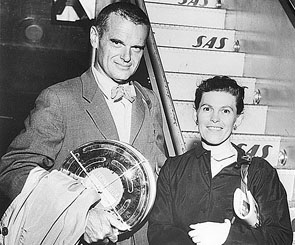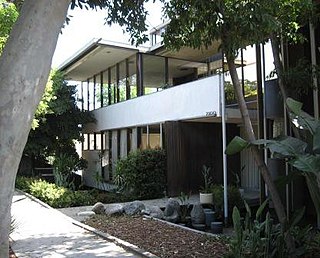
The Case Study Houses were experiments in American residential architecture sponsored by Arts & Architecture magazine, which commissioned major architects of the day, including Richard Neutra, Raphael Soriano, Craig Ellwood, Charles and Ray Eames, Pierre Koenig, Eero Saarinen, A. Quincy Jones, Edward Killingsworth, and Ralph Rapson to design and build inexpensive and efficient model homes for the United States residential housing boom caused by the end of World War II and the return of millions of soldiers.

The Ennis House is a residential dwelling in the Los Feliz neighborhood of Los Angeles, California, United States, south of Griffith Park. The home was designed by Frank Lloyd Wright for Charles and Mabel Ennis in 1923 and was built in 1924.

The Eames Lounge Chair and Ottoman is a lounge chair and ottoman manufactured and sold by American furniture company Herman Miller. Introduced in 1956, the Eames Lounge Chair was designed by Charles and Ray Eames and is made of molded plywood and leather. It was the first chair the Eameses designed for the high-end market. The Eames Lounge Chair and Ottoman are part of the permanent collection of New York's Museum of Modern Art.
Gregory Samuel Ain was an American architect active in the mid-20th century. Working primarily in the Los Angeles area, Ain is best known for bringing elements of modern architecture to lower- and medium-cost housing. He addressed "the common architectural problems of common people".

Vitra is a Swiss family-owned furniture company with headquarters in Birsfelden, Switzerland. It is the manufacturer of the works of many furniture designers. Vitra is also known for the works of notable architects that make up its premises in Weil am Rhein, Germany, in particular the Vitra Design Museum.

The Vitra Design Museum is a privately owned museum for design in Weil am Rhein, Germany.
Arts & Architecture (1929–1967) was an American design, architecture, landscape, and arts magazine. It was published and edited by John Entenza from 1938–1962 and David Travers 1962–1967. Arts & Architecture played a significant role both in Los Angeles's cultural history and in the development of West Coast modernism in general. The magazine's significant cultural contributions include its sponsorship of the Case Study Houses design-build-publication program.

Charles Ormond Eames Jr. was an American designer, architect and filmmaker. In professional partnership with his spouse Ray Kaiser Eames, he was responsible for groundbreaking contributions in the field of architecture, furniture design, industrial design, manufacturing and the photographic arts.

Bernice Alexandra Kaiser Eames was an American artist and designer who worked in a variety of media.

Charles Eames and Ray Eames were an American married couple of industrial designers who made significant historical contributions to the development of modern architecture and furniture through the work of the Eames Office. They also worked in the fields of industrial and graphic design, fine art, and film. Charles was the public face of the Eames Office, but Ray and Charles worked together as creative partners and employed a diverse creative staff. Among their most recognized designs is the Eames Lounge Chair and the Eames Dining Chair.
The Getty Conservation Institute (GCI), located in Los Angeles, California, is a program of the J. Paul Getty Trust. It is headquartered at the Getty Center but also has facilities at the Getty Villa, and commenced operation in 1985. The GCI is a private international research institution dedicated to advancing conservation practice through the creation and delivery of knowledge. It "serves the conservation community through scientific research, education and training, model field projects, and the dissemination of the results of both its own work and the work of others in the field" and "adheres to the principles that guide the work of the Getty Trust: service, philanthropy, teaching, and access." GCI has activities in both art conservation and architectural conservation.

The Getty Center, in Los Angeles, California, is a campus of the Getty Museum and other programs of the Getty Trust. The $1.3 billion center opened to the public on December 16, 1997, and is well known for its architecture, gardens, and views overlooking Los Angeles. The center sits atop a hill connected to a visitors' parking garage at the bottom of the hill by a three-car, cable-pulled hovertrain people mover.

The Bailey House, or Case Study House #21, is a steel-framed modernist house in the Hollywood Hills, designed by Pierre Koenig. It was registered as Los Angeles Historic-Cultural Monument #669, with the endorsement of then-owner Michael LaFetra, the Los Angeles Conservancy, and Pierre and Gloria Koenig.

Neutra VDL Studio and Residences, the home of architect Richard Neutra, is located in Los Angeles, California. It is also known as the Neutra Research House, the Van der Leeuw House, the Richard and Dion Neutra VDL Research House II, or the Richard and Dion Neutra VDL Research Houses and Studio. It was designed by Richard Neutra and his son Dion Neutra. The house is currently owned by California State Polytechnic University, Pomona, and is maintained by its College of Environmental Design. The property was added to the National Register of Historic Places in 2009, and was designated as a National Historic Landmark in 2016.
Los Angeles Modern Auctions (LAMA) is the first auction house to specialize in 20th century Modern art and design. Founded by Peter Loughrey in 1992, LAMA especially champions Modern and Contemporary works by California and West Coast artists and designers.

The Strathmore Apartments is a historic 8-unit multi-family complex located at 11005-11013 1/2 Strathmore Drive in the Westwood neighborhood of Los Angeles, California. Notable past residents, amongst others, include John Entenza, Charles Eames, Ray Eames, Luise Rainer, Clifford Odets, and Orson Welles.

Rolf Fehlbaum is chairman emeritus and active member of the board of directors of Vitra, a family-owned furniture company with headquarters in Birsfelden, Switzerland.

Deborah Sussman was an American designer and a pioneer in the field of environmental graphic design. Her work incorporated graphic design into architectural and public spaces.
Hodgetts + Fung, also known as HplusF, is an interdisciplinary design studio based in Culver City, California specializing in architectural design, advanced material fabrication, historical restorations, and exhibition design and is led by principals Craig Hodgetts and Hsinming Fung.
The Entenza House, also known as Case Study House #9, is a single occupancy residential building in Pacific Palisades, Los Angeles. The address is 205 Chautauqua Boulevard, Los Angeles California, 90272. It was designed by industrial designer Charles Eames, and architect Eero Saarinen for John Entenza as part of the Case Study House Program. The house was designed between 1945 and 1949 and construction was completed in 1950. Named accordingly, Entenza wanted to use the Case Study House #9 for himself as his private residence. He lived within the home for five years before selling it.



















